Family AmborellaceaePichon Scientific name Amborella Rank Genus | Clade Angiosperms Species A. trichopoda Higher classification Amborellaceae | |
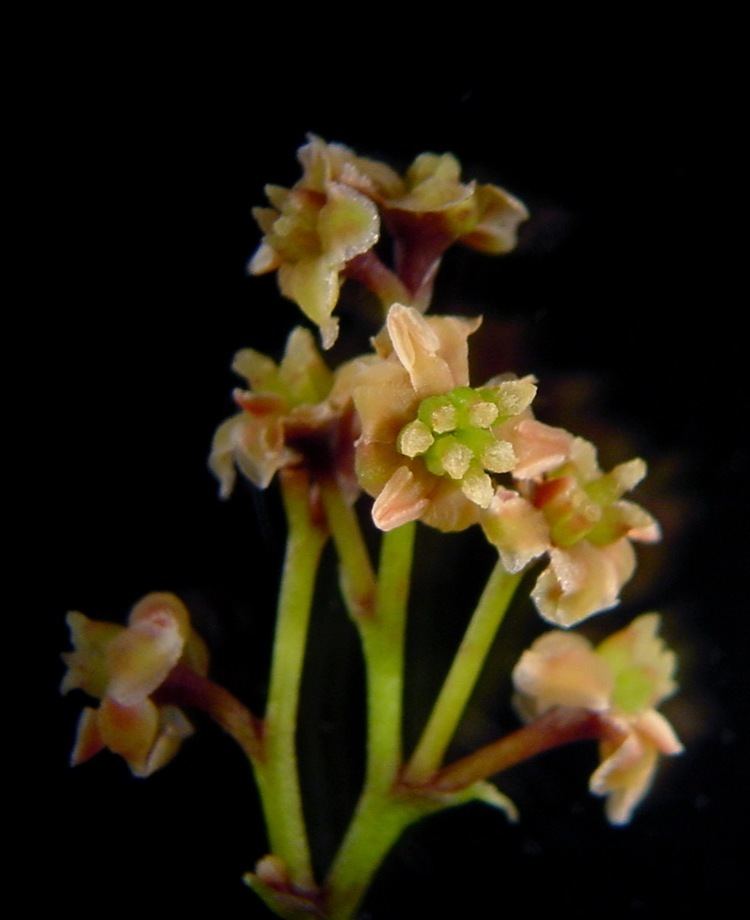 | ||
Order AmborellalesMelikyan, A.V.Bobrov, & Zaytzeva Lower classifications Amborella, Amborella trichopoda | ||
Amborella and the origin of flowers
Amborella is a monotypic genus of understory shrubs or small trees endemic to the main island, Grande Terre, of New Caledonia. The genus is the only member of the family Amborellaceae and the order Amborellales and contains a single species, Amborella trichopoda. The family Amborellaceae is therefore endemic to New Caledonia (along with Oncothecaceae and Phellinaceae), as well as the order Amborellales. Amborella is of great interest to plant systematists because molecular phylogenetic analyses consistently place the genus at or near the base of the flowering plant lineage.
Contents
- Amborella and the origin of flowers
- Ub research the amborella genome project
- Description
- Phylogeny
- Classification
- Older systems
- Genomic and evolutionary considerations
- Ecology
- Conservation
- References

Ub research the amborella genome project
Description
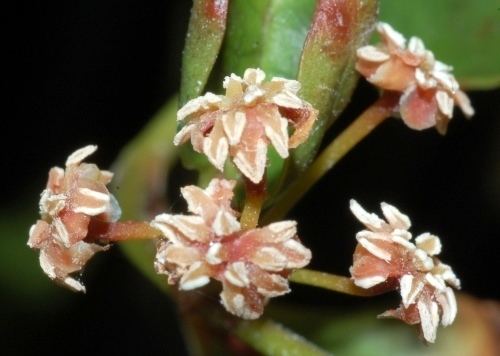
Amborella is a sprawling shrub or small tree up to 8 m high. It bears alternate or decussate, simple evergreen leaves without stipules. The leaves are two-ranked, with distinctly serrated or rippled margins, and about 8 to 10 cm long.
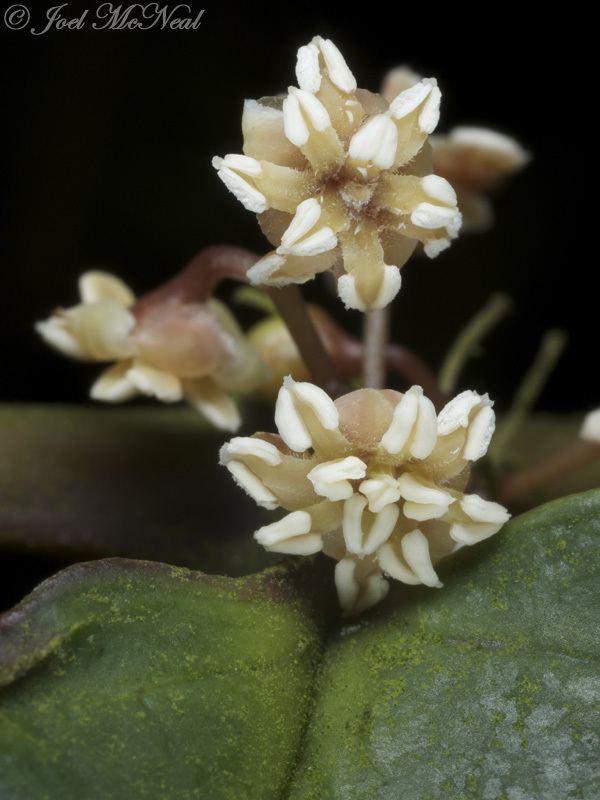
Amborella has xylem tissue that differs from that of most other flowering plants. The xylem of Amborella contains only tracheids; vessel elements are absent. Xylem of this form has long been regarded as a "primitive" feature of flowering plants.
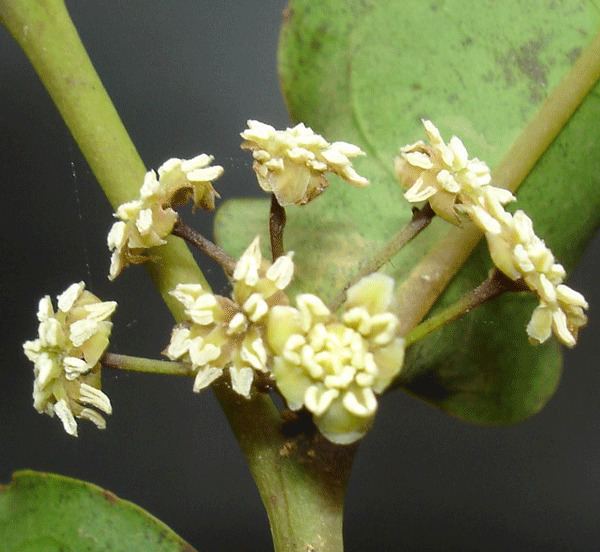
The species is dioecious. This means that each plant produces either "male flowers" (meaning that they have functional stamens) or "female flowers" (flowers with functional carpels), but not both. At any one time, a dioecious plant produces only functionally staminate or functionally carpellate flowers. Staminate ("male") Amborella flowers do not have carpels, whereas the carpellate ("female") flowers have non-functional "staminodes", structures resembling stamens in which no pollen develops. Plants may change from one reproductive morphology to the other. In one study, seven cuttings from a staminate plant produced, as expected, staminate flowers at their first flowering, but three of the seven produced carpellate flowers at their second flowering.
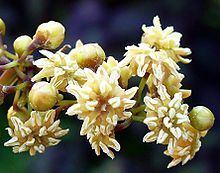
The small, creamy white, flowers are arranged in inflorescences borne in the axils of foliage leaves. The inflorescences have been described as cymes, with up to three orders of branching, each branch being terminated by a flower. Each flower is subtended by bracts. The bracts transition into a perianth of undifferentiated tepals. The tepals typically are arranged in a spiral, but sometimes are whorled at the periphery.

Carpellate flowers are roughly 3 to 4 mm in diameter, with 7 or 8 tepals. There are 1 to 3 (or rarely 0) well-differentiated staminodes and a spiral of 4 to 8 free (apocarpous) carpels. Carpels bear green ovaries; they lack a style. They contain a single ovule with the micropyle directed downwards. Staminate flowers are approximately 4 to 5 mm in diameter, with 6 to 15 tepals. These flowers bear 10 to 21 spirally arranged stamens, which become progressively smaller toward the center. The innermost may be sterile, amounting to staminodes. Stamens bear triangular anthers on short broad filaments. An anther consists of four pollen sacs, two on each side, with a small sterile central connective. The anthers have connective tips with small bumps and may be covered with secretions. These features suggest that, as with other basal angiosperms, there is a high degree of developmental plasticity.
Typically, 1 to 3 carpels per flower develop into fruit. The fruit is an ovoid red drupe (approximately 5 to 7 mm long and 5 mm wide) borne on a short (1 to 2 mm) stalk. The remains of the stigma can be seen at the tip of the fruit. The skin is papery, surrounding a thin fleshy layer containing a red juice. The inner pericarp is lignified and surrounds the single seed. The embryo is small and surrounded by copious endosperm.
Phylogeny
Currently plant systematists accept Amborella trichopoda as the most basal lineage in the clade of angiosperms. In systematics the term "basal" describes a lineage that diverges near the base of a phylogeny, and thus earlier than other lineages. Since Amborella is apparently basal among the flowering plants, the features of early flowering plants can be inferred by comparing derived traits shared by the main angiosperm lineage but not present in Amborella. These traits are presumed to have evolved after the divergence of the Amborella lineage.
One early twentieth century idea of "primitive" (i.e. ancestral) floral traits in angiosperms, accepted until relatively recently, is the Magnolia blossom model. This envisions flowers with numerous parts arranged in spirals on an elongated, cone-like receptacle rather than the small numbers of parts in distinct whorls of more derived flowers.
In a study designed to clarify relationships between well-studied model plants such as Arabidopsis thaliana, and the basal angiosperms Amborella, Nuphar (Nymphaeaceae), Illicium, the monocots, and more derived angiosperms (eudicots), chloroplast genomes using cDNA and expressed sequence tags for floral genes, the cladogram shown below was generated.
This hypothesized relationship of the extant seed plants places Amborella as the sister taxon to all other angiosperms, and shows the gymnosperms as a monophyletic group sister to the angiosperms. It supports the theory that Amborella branched off from the main lineage of angiosperms before the ancestors of any other living angiosperms. There is however some uncertainty about the relationship between the Amborellaceae and the Nymphaeales: one theory is that the Amborellaceae alone are the monophyletic sister to the extant angiosperms; another proposes that the Amborellaceae and Nymphaeales form a clade that is the sister group to all other extant angiosperms.
Because of its evolutionary position at the base of the flowering plant clade, there was support for sequencing the complete genome of Amborella trichopoda to serve as a reference for evolutionary studies. In 2010, the US National Science Foundation began a genome sequencing effort in Amborella, and the draft genome sequence was posted on the project website in December 2013.
Classification
Amborella is the only genus in the family Amborellaceae. The APG II system recognized this family, but left it unplaced at order rank due to uncertainty about its relationship to the family Nymphaeaceae. In the most recent APG system, APG III, the Amborellaceae comprise the monotypic order Amborellales at the base of the angiosperm phylogeny.
Older systems
The Cronquist system, of 1981, classified the family:
Order LauralesThe Thorne system (1992) classified it:
Order MagnolialesThe Dahlgren system classified it:
Order LauralesGenomic and evolutionary considerations
Amborella is of great interest to plant systematists because molecular phylogenetic analyses consistently place it at or near the base of the flowering plant lineage. That is, the Amborellaceae represent a line of flowering plants that diverged very early on (about 130 million years ago) from all the other extant species of flowering plants, and, among extant flowering plants, is the sister group to the other flowering plants. Comparing characteristics of this basal angiosperm, other flowering plants and fossils may provide clues about how flowers first appeared—what Darwin called the "abominable mystery". This position is consistent with a number of conservative characteristics of its physiology and morphology; for example, the wood of Amborella lacks the vessels characteristic of most flowering plants.
Amborella in the wild, being an understory plant, commonly is in intimate contact with shade- and moisture-dependent organisms such as algae, lichens and mosses. In the circumstances, it is not surprising in principle to find that there should have been horizontal gene transfer between Amborella and such associated species, but the scale of such transfer has in fact caused considerable surprise. Sequencing the Amborella mitochondrial genome revealed that for every gene of its own origin, it contains about six versions from the genomes of an assortment of the plants and algae growing with or upon it. The evolutionary and physiological significance of this is not as yet clear, nor in particular is it clear whether the horizontal gene transfer has anything to do with the apparent stability and conservatism of the species.
Ecology
Amborella is typically dioecious, but has been known to change sex in cultivation. Amborella has a mixed pollination system, relying on both insect pollinators and wind.
Conservation
The islands of New Caledonia are a biodiversity hot-spot, preserving many early diverging lineages of plants, of which Amborella is but one. This preservation has been ascribed to climate stability during and since the Tertiary (66 to 3 million years ago), stability that has permitted the continued survival of tropical forests, on New Caledonia. In contrast, drought conditions dominated the Australian climate towards the end of the Tertiary. Current threats to biodiversity in New Caledonia include fires, mining, agriculture, invasion by introduced species, urbanization and global warming. The importance of conserving Amborella has been dramatically stated by Pillon: "The disappearance of Amborella trichopoda would imply the disappearance of a genus, a family and an entire order, as well as the only witness to at least 140 million years of evolutionary history." Conservation strategies targeted on relic species are recommended, both preserving a diversity of habitats in New Caledonia and ex-situ conservation in cultivation.
